homes & gardens -- 2024
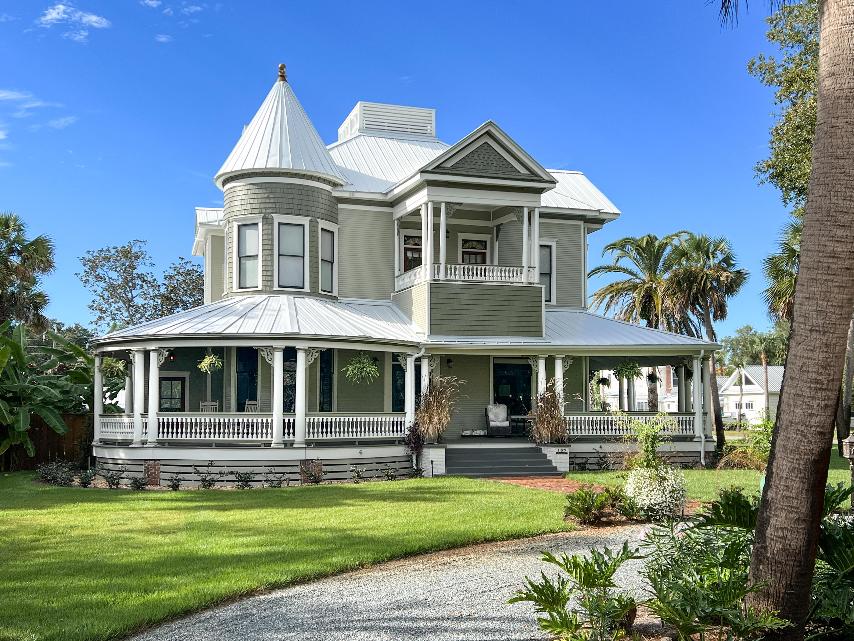
featured home -- 2024
The Porter House -- 127 Avenue B
Home of Connie and George Wilkerson
Richard Gibbs Porter Jr., the son of a pioneer businessman in Apalachicola, built this home of heart pine and cypress around 1901. Initially involved with Coombs and Company lumber dealers, he later became secretary and treasurer of Franklin County Lumber Company. In 1899 he and James F.C. Griggs founded the Apalachicola Electric Light Company. And in 1912, Porter organized Gulf Manufacturing Company, maker of cypress shingles.
Porter and his wife Steppie Rice, a teacher and principal at Chapman High School, raised three children here – Richard III, Edward (Ned), and Emily. Emily continued the educator legacy by teaching for over 30 years. Familiarly known to her students as “Miss Po,” she hosted parties in her home for members of the senior class. Generations of Apalachicolans have a Miss Po story.
The Florida Master Site File cites the house as one of Apalachicola’s better examples of the Queen Anne-style. “It utilizes the characteristic irregular plan, tower, and massed proportions along with some classical detailing. The house is very reflective of the lumber industry’s presence in town.”
“We tried to honor the house,” said Connie Wilkerson, who with her husband George, conducted a thoughtful and extensive restoration after purchasing the property in 2020.
When living in Little Rock, Arkansas, the Wilkersons vacationed on 30A. A love of oysters by George and son Aaron brought the family to Apalachicola. Curiosity shown by their adventuresome son Chance eventually led them to St. George Island. Attracted by the lack of crowds, George and Connie purchased a home on the beach. After living there, however, they realized a barrier island was not the place for their primary retirement home.
“I wanted this house, but it sold,” said Connie referring to the Porter House. She had looked several times at houses nearby when her real estate agent Anna-Maria Cannatella called saying, “Guess what? Your green house is back on the market!” It is this serendipitous moment that enabled this historic property to retain its history and charm.
Working with Erin Rodriguez Construction, the Wilkersons removed the previous shed additions – a laundry room, bathroom, pantry, and kitchen – and rebuilt them in a different configuration. In the kitchen and new areas, James Pendleton and crew meticulously replicated moldings to match the original. “A diminutive version,” said Connie, “because the ceilings are shorter.”
Except for below the bottom staircase, Kat Ross and Tommy Smith stripped the woodwork in the main room. To show the difference in stain colors, Connie requested the area not be stripped. “It darkened so much through the years, it was basically black,” she says. “You could not see the swirl patterns or the curly pine.” To be commended is Connie’s resoluteness in finding period lighting fixtures, plus a gentleman in Fort Lauderdale to rewire them.
According to George, the most important thing about the house is that over parts of the 1926 and 1927 seasons Ned Porter was a pitcher with the New York Giants baseball team. “In ’26 and ’27, guess who was playing for the Yankees?” asks George. “Babe Ruth, Lou Gehrig, Murderers’ Row! He would have pitched against them!”
The Tour of Homes is grateful to Connie and George for their compassionate stewardship. In celebrating 30 years, we proudly present the Porter House as the 2024 Featured Home.
Not ones to shy away from a project, the Wilkersons purchased the empty house behind them in 2022. Used for guests, the space also includes a garage for George’s old Bronco and a sewing room for Connie who loves to quilt.
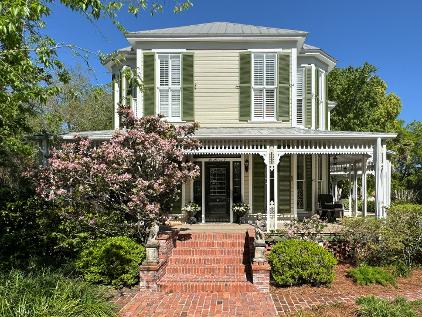
Collins-Lovett House -- 103 Avenue C
Home of Kate Rogers Berry and Jim Berry
One of the stateliest houses on Avenue C, this Queen Anne-style house, constructed of local pine and black cypress, dates to 1892. Interestingly, it was erected on the site of the former county jail.
Rudolph Collins built the house shortly after arriving from Pensacola. A successful merchant, Collins served on the board of pilot commissioners for the port of Apalachicola.
n 1918, John Patrick Lovett, another prosperous merchant and captain of the Franklin Guards, acquired the house. It remained in the family for 50 years. Sharon Lovett Carlson, a lifelong resident of Apalachicola who also resides on Avenue C, describes her grandparents’ home as, “happy and joyful with a baby grand and people playing and singing.”
The Florida Master Site File cites the Collins-Lovett house as a very interesting example of early Colonial Revival architecture with Eastlake influences, particularly in the porch treatment. The house underwent a complete renovation in 2000. The following year, Bill Barnes of Riverside Construction received a Chrysalis Award for best residential historic renovation.
It’s fitting this historic property is owned by Kate Rogers Berry and Jim Berry. Kate’s father, William Warren Rogers, was a professor of history at Florida State University for nearly 40 years. A prolific writer, Dr. Rogers wrote books on the history of Apalachicola and St. George Island.
Jim grew up in Marietta, Georgia, and spent his childhood “hunting relics” at Kennesaw Mountain on or near the Civil War battleground. His love of history and searching for its remnants is his passion. Framed prehistoric shark teeth found by Jim in South Carolina anchor the home’s den. Additional old found bottles, prehistoric teeth, and pottery shards (some from Apalach) are displayed in the sleeping porch upstairs.
Both Kate and Jim have a fondness for art, work by Forgotten Coast en Plein Air artists especially, and antiques. The couple were married at Trinity Episcopal Church in 2001.
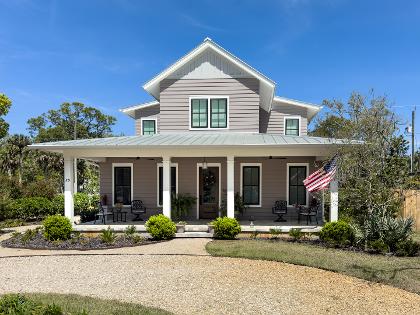
Edwards Home -- 59 15th Street
Home of Rennie and Tom Edwards
Rennie Edwards grew up in Selma, Alabama, with Patti McCartney, whose home is also on tour. It was on a visit to see Patti on St. George Island that Rennie and her husband Tom fell in love with the area. “That visit is the reason we built on the island,” says Rennie.
For over 20 years they enjoyed living on St. George, but as the one-hour round trip became too much, they decided to leave. “We moved because we were spending all our time in town and at Trinity,” says Rennie, who along with Tom, is instrumental in the life and vitality of Trinity church.
Built by Gary Ulrich Construction, the couple moved into their new light-filled home in July 2021. “Open, fun, comfortable, and great flow,” are features most liked by Rennie. Decreased utility bills make Tom smile.
Apart from family pieces, the Edwards left most of their furniture on the island. Some furnishings like the antique desk in the living area and large art pieces belonged to Tom’s sister and her husband, who both died tragically on 9/11. Barbara Gallagher, a respected Alabama artist, painted the colorful figures in the entry. A piece by well-known Brazilian artist Juarez Machado hangs over the fireplace.
A chest of drawers in the primary bedroom is a family heirloom that belonged to Tom’s grandfather. Upstairs are two guest rooms and living space. One bedroom is reserved for visits from grandchildren – there are seven! Another piece by Barbara Gallagher hangs in the den, a place where Rennie likes to practice her recorder (a woodwind musical instrument).
Tom can usually be found working, or sometimes puttering, in the yard. Designed by Tallahassee Nurseries, viburnum, hydrangeas, philodendron, and a variety of flowering and hardwood trees make up the custom landscape. The impressive cone-shaped flowers of the limelight hydrangeas are a showstopper. In bloom, they are worthy of a drive by in a golf cart even in summer’s heat.
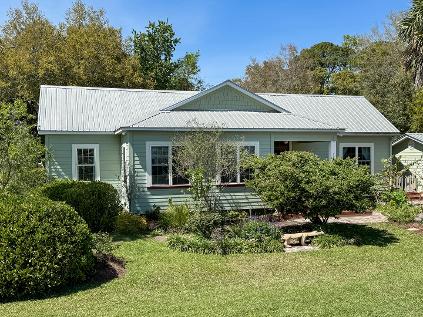
Pierce Home -- 183 Avenue D
Home of Alan Pierce
Armed with a master’s in planning, Alan Pierce came to Franklin County in 1988 to assist in development after Hurricane Elena devastated the shellfish industry.
After purchasing this Classical Revival-style house in 2000, Alan used it as a rental. Following an extensive renovation in 2009, he moved in full time. Along with replacing the flooring, sheetrock, and cabinetry, Alan added six feet to accommodate the kitchen and dining area.
The house’s original entry – a small door and porch that faced 15th Street – became part of the living room. With the help of an architect, Alan changed the three-bedroom 1000 square-foot home into a two-bedroom with 1400 square feet of living space.
The origin of this rectangular dwelling is uncertain. Alan believes the house was part of the officer’s quarters built during World War II at the Apalachicola Army Field (now airport), then moved into town in the 1950s. What is clear is the home is filled with intriguing items, family pieces, and art, all of which hold special meaning for him.
A wood ruler inscribed Class of 1907 by his maternal grandfather while at Harvard is one such object. A photograph capturing Alan’s father in front of the hardware store Alan’s grandfather owned in Key West is another. Hanging above the TV is a painting a friend made depicting Alan’s home in Keys. And then there are the shark teeth he collected as a child.
In 2023 county commissioners recognized Alan for his years of service to the community, including his time as Apalachicola mayor. The Tour of Homes is also appreciative. A member of Trinity Episcopal Church, Alan graciously opened his home in 2009 and 2013, and showcased his garden in 2017.
Alan’s green thumb continues to create a peaceful oasis. A loss of shade caused by Hurricane Michael in 2018 prompted him to remake the backyard. A new outdoor kitchen enhances the space while a honeysuckle vine provides shelter.
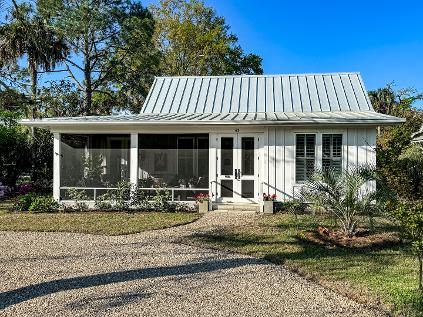
McCartney Home -- 62 15th Street
Home of Patti and Bill McCartney
After mosquitos, climate change, weekly renters as neighbors, and Hurricane Michael, one learns the real motive why Patti and Bill McCartney left St. George Island. Before moving in September 2022 into a coastalcottage built by Gary Ulrich Construction, the couple lived for 22 years on Apalachicola Bay in a three-story house.
Although they were already part of Apalachicola – through Trinity Episcopal Church and Bill’s work as a community development consultant – their real motive behind leaving the island is a sense of community. “We came to join the community,” says Bill, “a real community.”
For Bill, the town is like the Fort Walton he knew growing up. Bill’s great-grandfather, a founder of Fort Walton, brought him to Apalachicola in 1948 for a stay at the Gibson Hotel.
“We wanted our new home to blend into the community,” says Bill who designed their house to have the feel of Old Florida cottages. “We have native materials to the extent we could use them; the cypress is native Florida cypress.”
Intentional in placement, the sunroom faces south to receive winter sun while large eaves on the front block the heat in summer. These porches overlook another point of pride – the landscape. Starting with no vegetation, Bill and Patti selected and planted all that is growing – over 150 plants.
The couple’s family antiques and artwork spark memories and stories. The 1880s wicker furniture in the sunroom belonged to Bill’s great-grandparents. His great-grandfather’s bookcases, filing cabinet, and library table (now Bill’s desk), adorn the study. The fireplace mantle is a piece salvaged from the keeper’s house of the Cape St. George Lighthouse after it was destroyed by a hurricane.
Downsizing works for people of all ages and for many reasons. This cottage offers a nice lesson on the benefits of smaller living. “Oh, there’s Mary Anne,” says Patti laughingly, as a friend walks past the sunroom. “We were ready to move to town and watch our neighbors go by. We couldn’t do that on the island.”
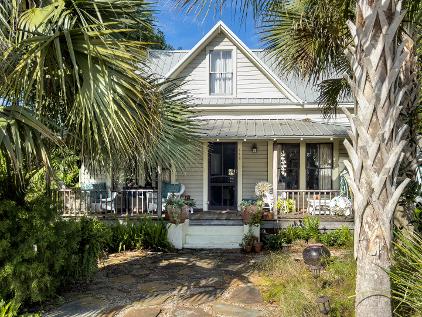
Tobiason Home -- 115 15th Street
Home of Laurel and Erik Tobiason
“I did snow until I was 60. I’m done,” says Laurel Tobiason. When Laurel worked in the Vermont school system, she, and her husband Erik (or Rik, as she calls him), would come to Florida in a camper for spring break. After discovering the Florida State Park system, St. Joseph and St. George Island became favorites. As they traveled between the two, they found Apalach.
“One day, we were coming across the bridge, and I said to Erik you know I think I could live here, and he said let’s look for a house,” recalls Laurel. Within two weeks they had looked, chosen, and put a contract on a house – the house behind them.
In 2017 while renovating their new home, friends who lived behind them on 15th Street decided to sell their house. “We said, ‘How much?’ and then we bought it. It took two weeks to sell ours. I didn’t even get to cook in the kitchen,” says Laurel, “the new kitchen.” Although they loved their house, a small foursquare, they couldn’t resist the larger one with its lot and layout.
With work overseen by Erik, the Tobiasons work diligently to preserve and maintain their Queen Anne cottage made of cypress and heart pine. As a builder, Erik has years of experience in construction, renovation, and restoration.
One large transformation that changed the look of the house involved removing a back deck and stairs. Possibly in the 1990s, when a mother and daughter owned the home, the attic was made into an apartment. Today a picturesque window, instead of a door, encloses the warm space used by guests and by Laurel as a sewing room and art studio. A bed for Sheba the cat sits nearby. If she’s painted too long, he lets her know. “He’ll walk right across whatever I’m doing and say it’s time for dinner.”
A photographer and artist, Laurel’s photographs are featured in the home’s entry. Her artwork includes watercolor, ink, and tissue paper collage.
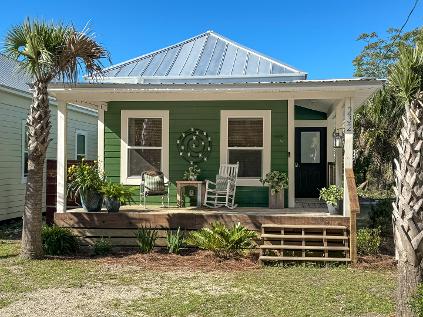
Isaiah Abrams House -- 232 8th Street
Restoration by LaRaela Lee-Coxwell and Glen Coxwell
Residence of Meghan Davis
While burying a St. Joseph statue in the yard may bring good fortune to some selling a home, there is likely no ritual or charm that works as well as Meghan Davis. Since deciding to downsize a decade ago, Meghan has brought luck to many sellers. A home placed on the market for 17 years sold in two and a half months after Meghan moved in with her belongings.
In finding a new place, Meghan asked her real estate friend Shannon for help in renting a townhouse from a Tallahassee gentleman who owned four. In the 12 years the homes were for sale, he had received no offers. But after Meghan arrived, one briskly sold. In returning her favor, Meghan allowed Shannon to show her townhome. Then, after all those years, it sold. Meghan recalls thinking, “Oh my gosh, I have to keep moving. I’m not even going to decorate!”
Luckily for Meghan, her creative eye and styling talents are safe for now. Not only is her landlord a friend, but she’s also her first cousin. LaRaela Lee-Coxwell and her husband Glen Coxwell purchased a row of shotguns at the end of 8th Street in January 2021. Intent on rehabbing them, Glen and LaRaela finished the first one in ten months – #230 located next door. Rehabilitating these houses is a labor of love for the couple whose own home sits two streets away.
Located in the African American “Hill” neighborhood, it is believed Apalachicola’s shotguns were built by enterprising individuals as sources of rental income. In 1912 at the age of 30, Isaiah Abrams, an African American carpenter, purchased two lots on which he is said to have built a row of shotguns. In 1926 he purchased an additional two lots to the left of the shotguns and built these three houses using heart pine and cypress from the local mill.
Sawmill workers, crab pickers, and people employed in the seafood industry rented these small homes and raised families in them. Unfortunately, as jobs declined, the community was forced to migrate away from the Hill. Eventually, the homes were abandoned and fell into disrepair. Because of the work undertaken by Glen and LaRaela, these houses will thankfully be part of the Hill community for years to come.
Meghan is the first person to live at 232 8th Street since it was finished last year. Happily, the exterior is painted her favorite color. Along with the home organizing and design skills she honed at a young age, Meghan also has a green thumb. For Meghan, as well as our tour participants, we’re glad she’s able to stay awhile.
While there’s a movie about traveling pants, Meghan’s story is about a traveling bed. Tour this unique home to hear her tale.
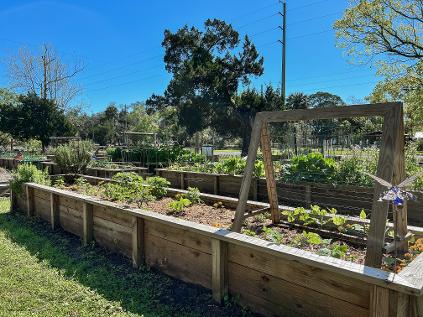
Apalachicola City Square Community
Garden -- Corners of 8th St and Ave F
Whether for experienced gardeners or beginners who want to get their hands dirty, community gardens give people the opportunity and space to grow their own food, be part of a community, and learn about edible gardening. Apalachicola’s community garden is no exception.
Founded in 2011, the Apalachicola City Square Community Garden is a place where neighbors representing the diversity of Apalachicola can connect, collaborate, and grow delicious, healthy, and beautiful food and medicine.
To help protect the land and Apalachicola Bay, vegetables, fruits, flowers, and herbs are grown organically using sustainable and earth-friendly ways. Gardening is viewed as a method to increase food security, improve health and well-being, and help strengthen this special community.
Today about 40 gardeners tend 28 boxes, plus an orchard and pollinator garden. A Community Share Veggie Stand offers extra produce and goods.
The community garden is managed by a committee of five to seven members who assist with community coordination by processing new memberships, collecting dues, and maintaining infrastructure. A garden coordinator collaborates with this committee, and a treasurer oversees the budget. For a sliding scale fee of $40 - $80 (to ensure accessibility by all interested), gardeners receive the use of a bed, water, and mulch when available.
On tour day, gardeners will be on hand to talk about their growing efforts. At this time of year, you’re likely to find tomatoes, squash, beans, cucumbers, peppers, eggplant, corn, okra, and herbs in the boxes.